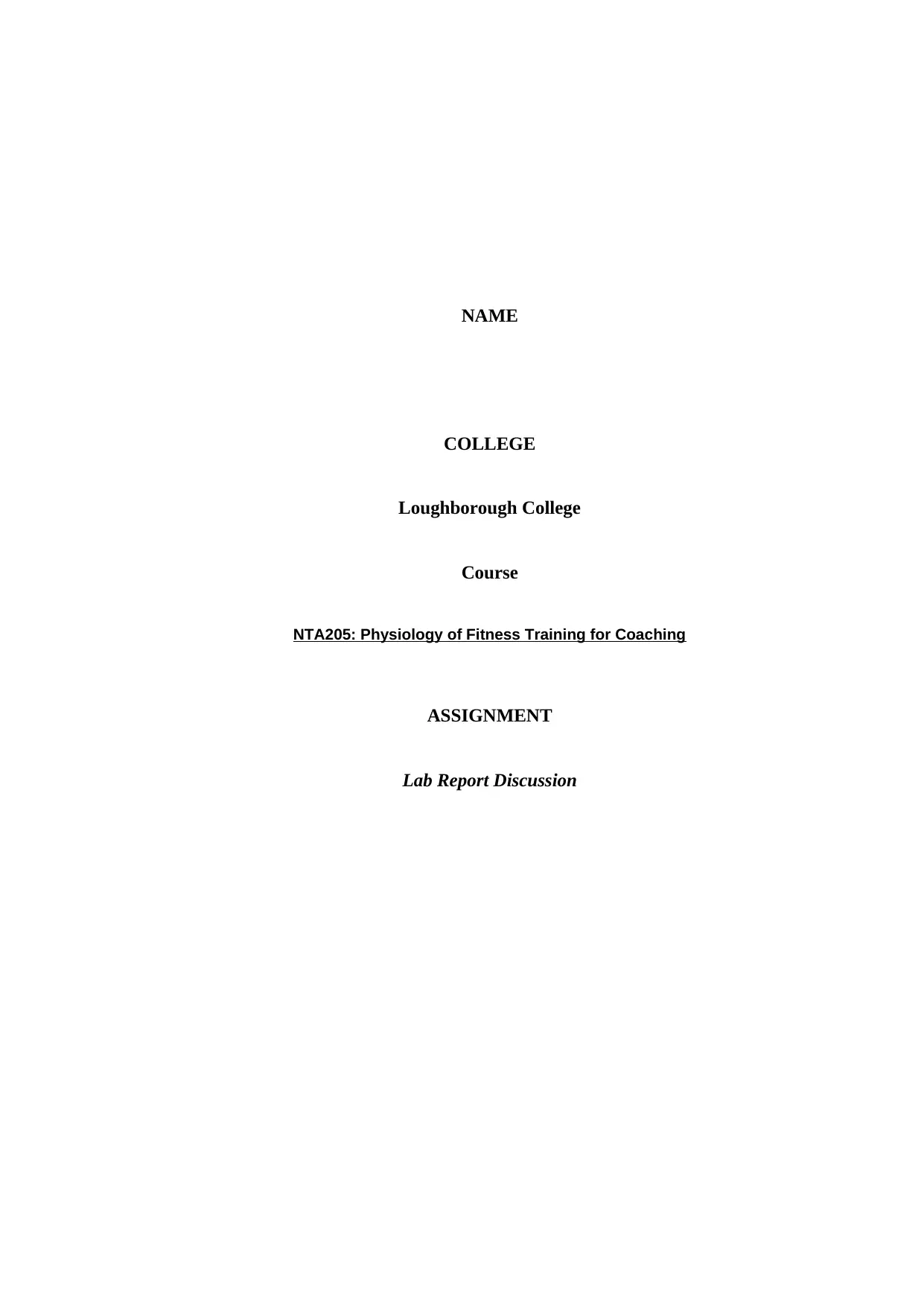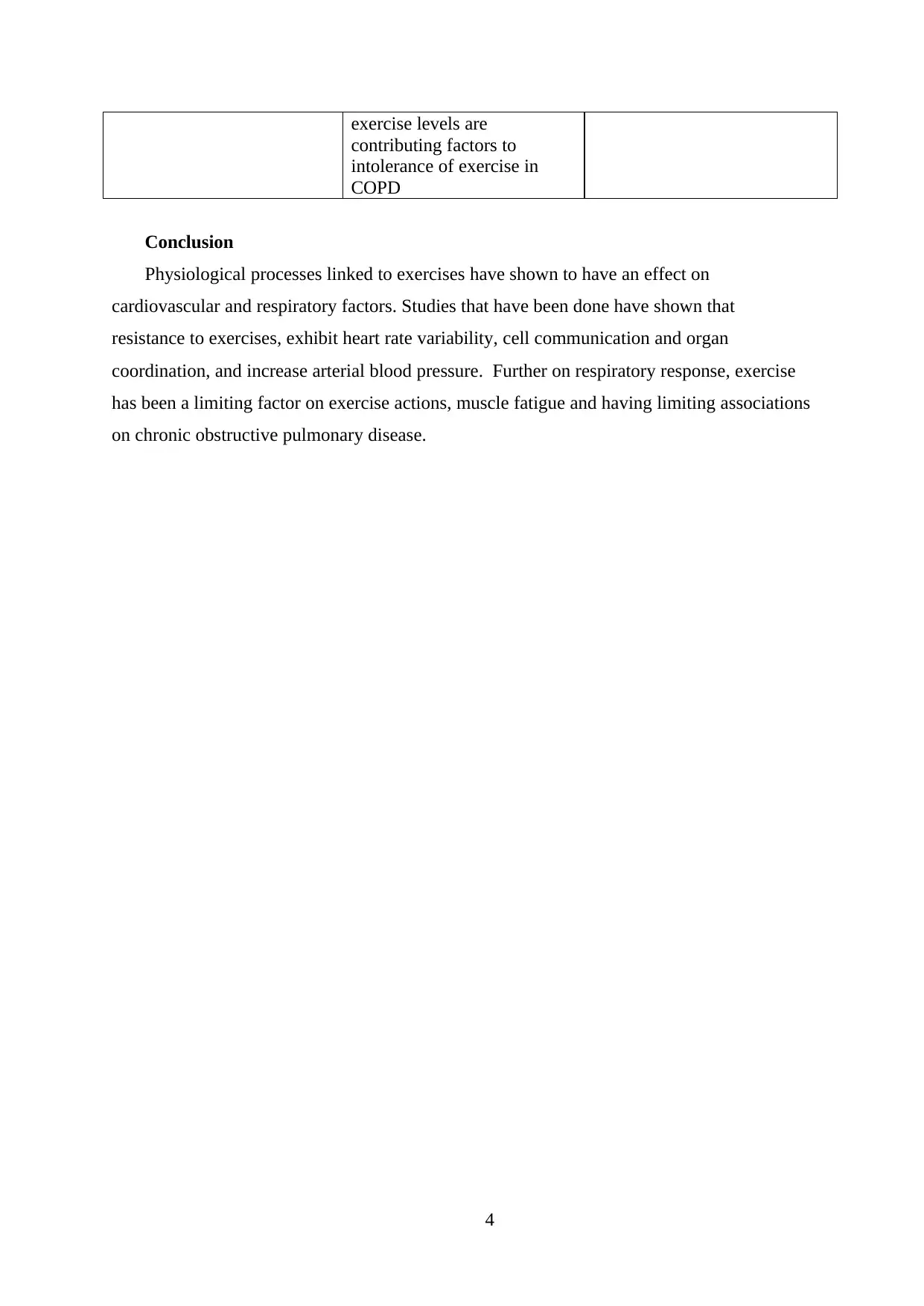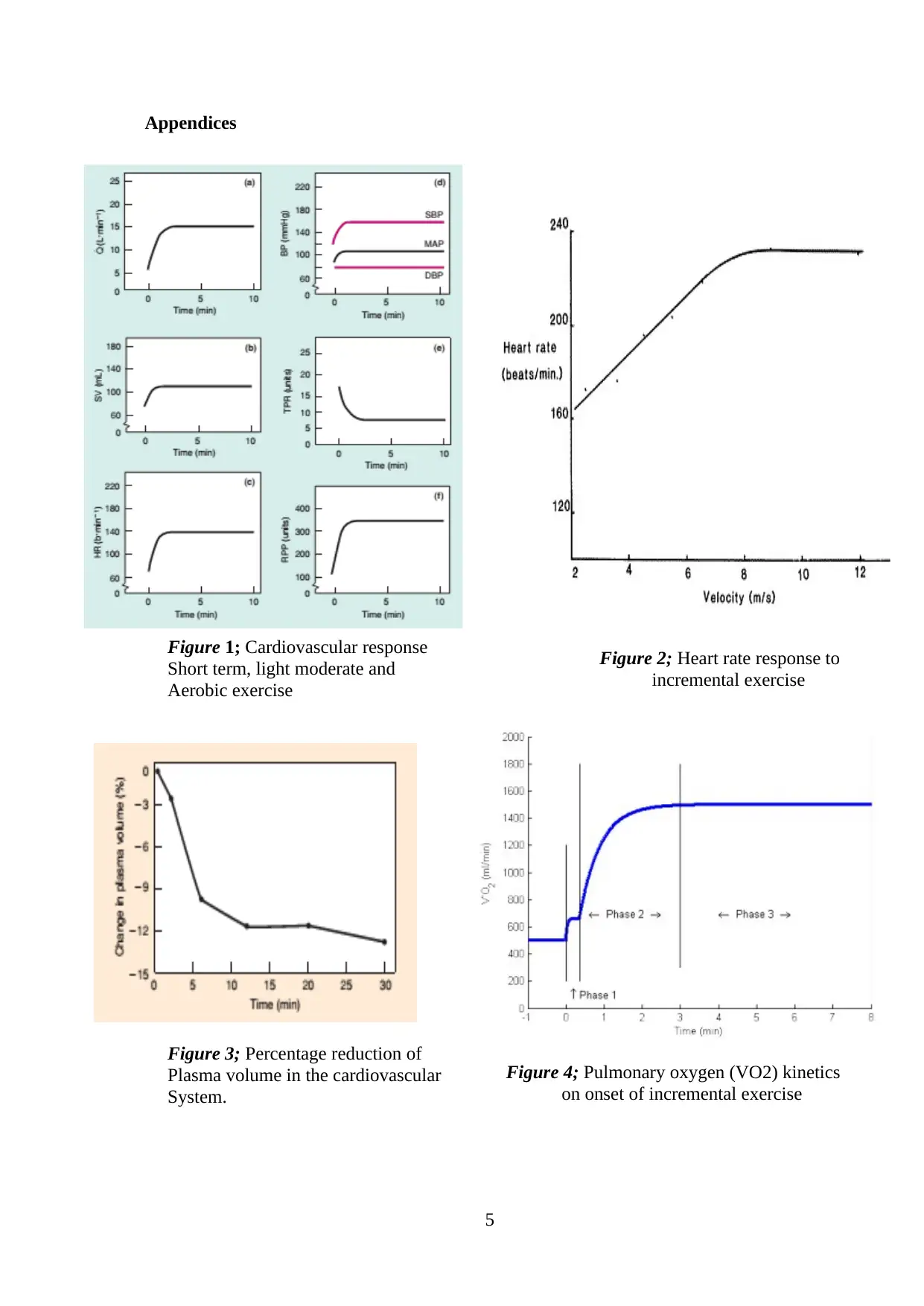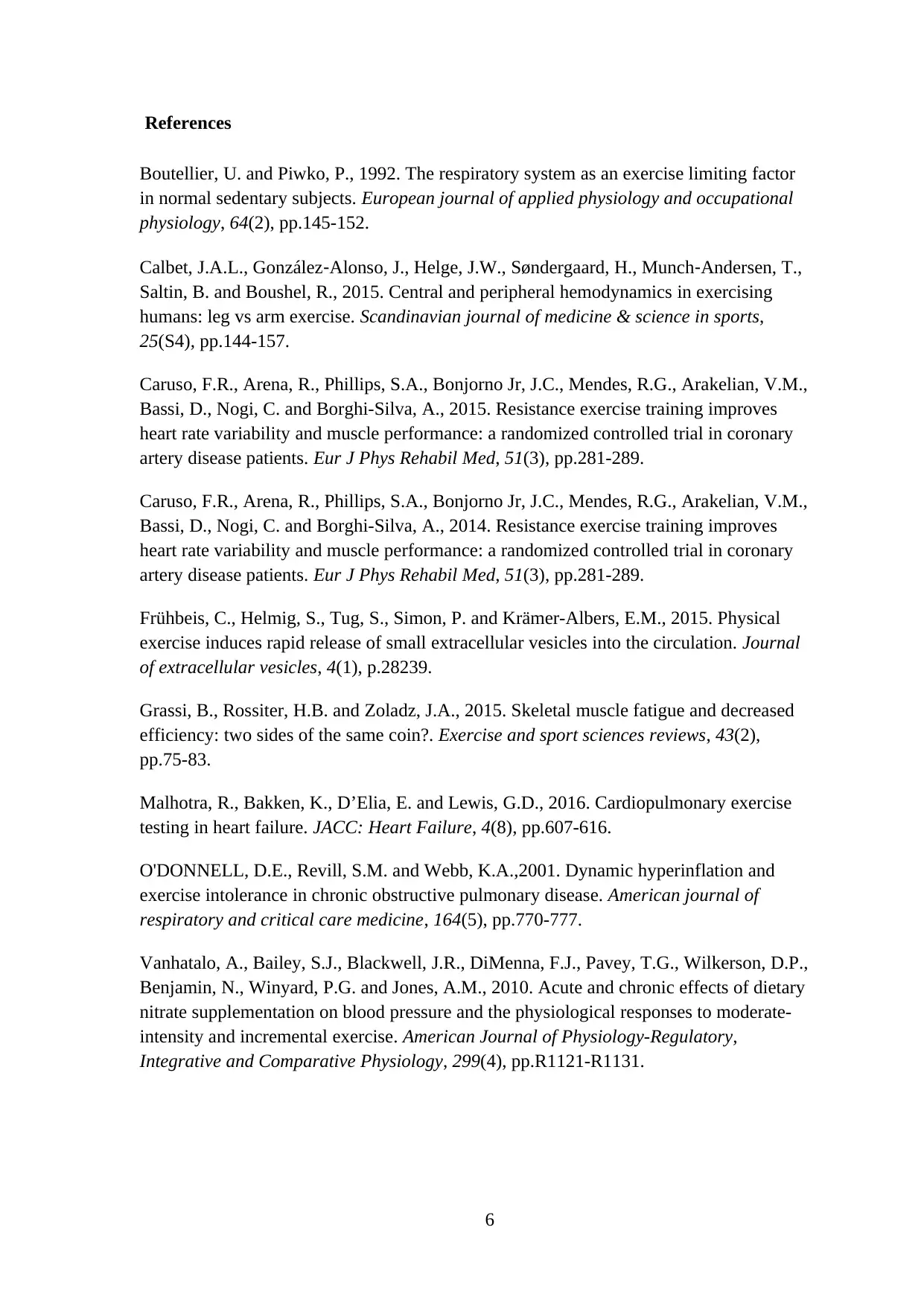NTA205 Physiology of Fitness Training: Lab Report on Exercise Effects
VerifiedAdded on 2021/04/17
|6
|1208
|25
Report
AI Summary
This lab report, submitted for the NTA205 Physiology of Fitness Training course at Loughborough College, examines the effects of incremental exercise on the cardiovascular and respiratory systems. The report employs a meta-analysis of existing literature, focusing on studies related to cardiovascular and respiratory responses to exercise initiation. The report discusses the consistencies and differences observed in the literature, highlighting the impact of exercise on arterial blood pressure, muscle mass, extracellular vesicles, and heart rate variability within the cardiovascular system. In terms of the respiratory system, the report explores how exercise can be a limiting factor, leading to muscle fatigue and altered sensation of dyspnea, and dynamic hyperinflation in chronic obstructive pulmonary disease. The conclusion emphasizes the influence of exercise on these physiological processes, citing key findings from various studies and including supporting figures and references.

NAME
COLLEGE
Loughborough College
Course
NTA205: Physiology of Fitness Training for Coaching
ASSIGNMENT
Lab Report Discussion
COLLEGE
Loughborough College
Course
NTA205: Physiology of Fitness Training for Coaching
ASSIGNMENT
Lab Report Discussion
Paraphrase This Document
Need a fresh take? Get an instant paraphrase of this document with our AI Paraphraser

Introduction
Incremental exercises are activities undertaken at an increased intensity over time.
Variables which determine the rate of exercises vary in terms of starting rate, duration and
increments over time. It has been utilised widely in corpus health studies in assessing various
related propositions which incorporate aerobic exercise responses, (Vanhatalo et al. 2010).
In clinical set ups, incremental exercises have been used in establishing associations of
patients on cardiac stress testing, cardiovascular and pulmonary exercise test , assessing
exercise induced asthma.
Methods
The search strategy involved a Meta analysis of literature related to cardiovascular and
respiratory effects on exercise initiation. The search engines used were, NCBI, PubMed and
Springer Link.
The key search words were, ‘Cardiovascular and respiratory responses on incremental
exercises’.
Results and discussion
Cardiovascular system to incremental exercise
When muscles initiate exercise, they dilate the arteriole which serves the muscles thus
allowing more blood flow. The occurring vasodilatation lowers the peripheral resistance
which is related to mean arterial pressure, (Malhotra et al. 2016).
This report analyses consistencies and differences which literature review has cited with
regard to incremental exercise on cardiovascular system. The results are discussed in the table
below;
Consistencies of data
Author Consistency Differences observed
Calbert et al., (2015) - Exercises have been thought
to increase arterial blood pressure.
- Assessment of
hemodynamic response of upright
arm cracking, leg pedalling, peak
cardiac output and stroke volume
were 1 8%, 23%, and 20% lower
during arm cracking than leg
pedaling
- With lower cardiac output
cardiovascular strain in arm
cracking is higher in leg pedalling
Carusso et al., (2015) - In high intensity
exercises muscle mass and
2
Incremental exercises are activities undertaken at an increased intensity over time.
Variables which determine the rate of exercises vary in terms of starting rate, duration and
increments over time. It has been utilised widely in corpus health studies in assessing various
related propositions which incorporate aerobic exercise responses, (Vanhatalo et al. 2010).
In clinical set ups, incremental exercises have been used in establishing associations of
patients on cardiac stress testing, cardiovascular and pulmonary exercise test , assessing
exercise induced asthma.
Methods
The search strategy involved a Meta analysis of literature related to cardiovascular and
respiratory effects on exercise initiation. The search engines used were, NCBI, PubMed and
Springer Link.
The key search words were, ‘Cardiovascular and respiratory responses on incremental
exercises’.
Results and discussion
Cardiovascular system to incremental exercise
When muscles initiate exercise, they dilate the arteriole which serves the muscles thus
allowing more blood flow. The occurring vasodilatation lowers the peripheral resistance
which is related to mean arterial pressure, (Malhotra et al. 2016).
This report analyses consistencies and differences which literature review has cited with
regard to incremental exercise on cardiovascular system. The results are discussed in the table
below;
Consistencies of data
Author Consistency Differences observed
Calbert et al., (2015) - Exercises have been thought
to increase arterial blood pressure.
- Assessment of
hemodynamic response of upright
arm cracking, leg pedalling, peak
cardiac output and stroke volume
were 1 8%, 23%, and 20% lower
during arm cracking than leg
pedaling
- With lower cardiac output
cardiovascular strain in arm
cracking is higher in leg pedalling
Carusso et al., (2015) - In high intensity
exercises muscle mass and
2

lowered respiratory
inefficiency are closely
attached which lead to
exercise intolerance
Frühbeis, (2015) - Extracellular vesicles have
been shown to have an effect on
cell communication and tissue
related functions
- Thus extracellular vesicles
during physical activity engage in
cell communication during exercise
induced process which incorporate
communication across
tissues and organs
Caruso et al., (2014) - Resistance exercises as used
in cardiac rehabilitation have
impacts on heart rate variability.
The results indicate positive muscle
strength and endurance among
coronary heart patients.
Response of the respiratory system to incremental exercise
The ultimate function of the respiratory system to the cardiovascular system is to ensure
there is flow and adequate supply of oxygen due to the muscles contracting. The respiratory
systems are meant to ensure that arterial oxygen saturation is reached thus ensuring carbon
dioxide is removed from the muscles, (Frühbeis et al. 2015).
Author Consistency Differences observed
Bouteller & Piwiko, (1991) - - Respiratory system has
been studied as a limiting
factor in exercise actions. The
results indicate respiratory
exercise as a limiting factor in
endurance test in sedentary
subjects.
Grassi et al., (2015) - Respiratory fatigue
attributed to muscle fatigue are
linked to limiting the tolerance
of exercises and altered
sensation of dyspenia.
Donnell,, Revill & Web, (2000) - Dynamic
hyperinflation in exercise has
been shown to have limitation
in chronic obstructive
pulmonary disease.
- It portrays the
inability of volume attained
in increased response to
3
inefficiency are closely
attached which lead to
exercise intolerance
Frühbeis, (2015) - Extracellular vesicles have
been shown to have an effect on
cell communication and tissue
related functions
- Thus extracellular vesicles
during physical activity engage in
cell communication during exercise
induced process which incorporate
communication across
tissues and organs
Caruso et al., (2014) - Resistance exercises as used
in cardiac rehabilitation have
impacts on heart rate variability.
The results indicate positive muscle
strength and endurance among
coronary heart patients.
Response of the respiratory system to incremental exercise
The ultimate function of the respiratory system to the cardiovascular system is to ensure
there is flow and adequate supply of oxygen due to the muscles contracting. The respiratory
systems are meant to ensure that arterial oxygen saturation is reached thus ensuring carbon
dioxide is removed from the muscles, (Frühbeis et al. 2015).
Author Consistency Differences observed
Bouteller & Piwiko, (1991) - - Respiratory system has
been studied as a limiting
factor in exercise actions. The
results indicate respiratory
exercise as a limiting factor in
endurance test in sedentary
subjects.
Grassi et al., (2015) - Respiratory fatigue
attributed to muscle fatigue are
linked to limiting the tolerance
of exercises and altered
sensation of dyspenia.
Donnell,, Revill & Web, (2000) - Dynamic
hyperinflation in exercise has
been shown to have limitation
in chronic obstructive
pulmonary disease.
- It portrays the
inability of volume attained
in increased response to
3
⊘ This is a preview!⊘
Do you want full access?
Subscribe today to unlock all pages.

Trusted by 1+ million students worldwide

exercise levels are
contributing factors to
intolerance of exercise in
COPD
Conclusion
Physiological processes linked to exercises have shown to have an effect on
cardiovascular and respiratory factors. Studies that have been done have shown that
resistance to exercises, exhibit heart rate variability, cell communication and organ
coordination, and increase arterial blood pressure. Further on respiratory response, exercise
has been a limiting factor on exercise actions, muscle fatigue and having limiting associations
on chronic obstructive pulmonary disease.
4
contributing factors to
intolerance of exercise in
COPD
Conclusion
Physiological processes linked to exercises have shown to have an effect on
cardiovascular and respiratory factors. Studies that have been done have shown that
resistance to exercises, exhibit heart rate variability, cell communication and organ
coordination, and increase arterial blood pressure. Further on respiratory response, exercise
has been a limiting factor on exercise actions, muscle fatigue and having limiting associations
on chronic obstructive pulmonary disease.
4
Paraphrase This Document
Need a fresh take? Get an instant paraphrase of this document with our AI Paraphraser

Appendices
Figure 1; Cardiovascular response
Short term, light moderate and
Aerobic exercise
Figure 3; Percentage reduction of
Plasma volume in the cardiovascular
System.
5
Figure 2; Heart rate response to
incremental exercise
Figure 4; Pulmonary oxygen (VO2) kinetics
on onset of incremental exercise
Figure 1; Cardiovascular response
Short term, light moderate and
Aerobic exercise
Figure 3; Percentage reduction of
Plasma volume in the cardiovascular
System.
5
Figure 2; Heart rate response to
incremental exercise
Figure 4; Pulmonary oxygen (VO2) kinetics
on onset of incremental exercise

References
Boutellier, U. and Piwko, P., 1992. The respiratory system as an exercise limiting factor
in normal sedentary subjects. European journal of applied physiology and occupational
physiology, 64(2), pp.145-152.
Calbet, J.A.L., González‐Alonso, J., Helge, J.W., Søndergaard, H., Munch‐Andersen, T.,
Saltin, B. and Boushel, R., 2015. Central and peripheral hemodynamics in exercising
humans: leg vs arm exercise. Scandinavian journal of medicine & science in sports,
25(S4), pp.144-157.
Caruso, F.R., Arena, R., Phillips, S.A., Bonjorno Jr, J.C., Mendes, R.G., Arakelian, V.M.,
Bassi, D., Nogi, C. and Borghi-Silva, A., 2015. Resistance exercise training improves
heart rate variability and muscle performance: a randomized controlled trial in coronary
artery disease patients. Eur J Phys Rehabil Med, 51(3), pp.281-289.
Caruso, F.R., Arena, R., Phillips, S.A., Bonjorno Jr, J.C., Mendes, R.G., Arakelian, V.M.,
Bassi, D., Nogi, C. and Borghi-Silva, A., 2014. Resistance exercise training improves
heart rate variability and muscle performance: a randomized controlled trial in coronary
artery disease patients. Eur J Phys Rehabil Med, 51(3), pp.281-289.
Frühbeis, C., Helmig, S., Tug, S., Simon, P. and Krämer-Albers, E.M., 2015. Physical
exercise induces rapid release of small extracellular vesicles into the circulation. Journal
of extracellular vesicles, 4(1), p.28239.
Grassi, B., Rossiter, H.B. and Zoladz, J.A., 2015. Skeletal muscle fatigue and decreased
efficiency: two sides of the same coin?. Exercise and sport sciences reviews, 43(2),
pp.75-83.
Malhotra, R., Bakken, K., D’Elia, E. and Lewis, G.D., 2016. Cardiopulmonary exercise
testing in heart failure. JACC: Heart Failure, 4(8), pp.607-616.
O'DONNELL, D.E., Revill, S.M. and Webb, K.A.,2001. Dynamic hyperinflation and
exercise intolerance in chronic obstructive pulmonary disease. American journal of
respiratory and critical care medicine, 164(5), pp.770-777.
Vanhatalo, A., Bailey, S.J., Blackwell, J.R., DiMenna, F.J., Pavey, T.G., Wilkerson, D.P.,
Benjamin, N., Winyard, P.G. and Jones, A.M., 2010. Acute and chronic effects of dietary
nitrate supplementation on blood pressure and the physiological responses to moderate-
intensity and incremental exercise. American Journal of Physiology-Regulatory,
Integrative and Comparative Physiology, 299(4), pp.R1121-R1131.
6
Boutellier, U. and Piwko, P., 1992. The respiratory system as an exercise limiting factor
in normal sedentary subjects. European journal of applied physiology and occupational
physiology, 64(2), pp.145-152.
Calbet, J.A.L., González‐Alonso, J., Helge, J.W., Søndergaard, H., Munch‐Andersen, T.,
Saltin, B. and Boushel, R., 2015. Central and peripheral hemodynamics in exercising
humans: leg vs arm exercise. Scandinavian journal of medicine & science in sports,
25(S4), pp.144-157.
Caruso, F.R., Arena, R., Phillips, S.A., Bonjorno Jr, J.C., Mendes, R.G., Arakelian, V.M.,
Bassi, D., Nogi, C. and Borghi-Silva, A., 2015. Resistance exercise training improves
heart rate variability and muscle performance: a randomized controlled trial in coronary
artery disease patients. Eur J Phys Rehabil Med, 51(3), pp.281-289.
Caruso, F.R., Arena, R., Phillips, S.A., Bonjorno Jr, J.C., Mendes, R.G., Arakelian, V.M.,
Bassi, D., Nogi, C. and Borghi-Silva, A., 2014. Resistance exercise training improves
heart rate variability and muscle performance: a randomized controlled trial in coronary
artery disease patients. Eur J Phys Rehabil Med, 51(3), pp.281-289.
Frühbeis, C., Helmig, S., Tug, S., Simon, P. and Krämer-Albers, E.M., 2015. Physical
exercise induces rapid release of small extracellular vesicles into the circulation. Journal
of extracellular vesicles, 4(1), p.28239.
Grassi, B., Rossiter, H.B. and Zoladz, J.A., 2015. Skeletal muscle fatigue and decreased
efficiency: two sides of the same coin?. Exercise and sport sciences reviews, 43(2),
pp.75-83.
Malhotra, R., Bakken, K., D’Elia, E. and Lewis, G.D., 2016. Cardiopulmonary exercise
testing in heart failure. JACC: Heart Failure, 4(8), pp.607-616.
O'DONNELL, D.E., Revill, S.M. and Webb, K.A.,2001. Dynamic hyperinflation and
exercise intolerance in chronic obstructive pulmonary disease. American journal of
respiratory and critical care medicine, 164(5), pp.770-777.
Vanhatalo, A., Bailey, S.J., Blackwell, J.R., DiMenna, F.J., Pavey, T.G., Wilkerson, D.P.,
Benjamin, N., Winyard, P.G. and Jones, A.M., 2010. Acute and chronic effects of dietary
nitrate supplementation on blood pressure and the physiological responses to moderate-
intensity and incremental exercise. American Journal of Physiology-Regulatory,
Integrative and Comparative Physiology, 299(4), pp.R1121-R1131.
6
⊘ This is a preview!⊘
Do you want full access?
Subscribe today to unlock all pages.

Trusted by 1+ million students worldwide
1 out of 6
Related Documents
Your All-in-One AI-Powered Toolkit for Academic Success.
+13062052269
info@desklib.com
Available 24*7 on WhatsApp / Email
![[object Object]](/_next/static/media/star-bottom.7253800d.svg)
Unlock your academic potential
Copyright © 2020–2025 A2Z Services. All Rights Reserved. Developed and managed by ZUCOL.





